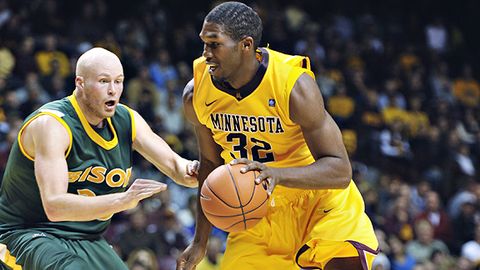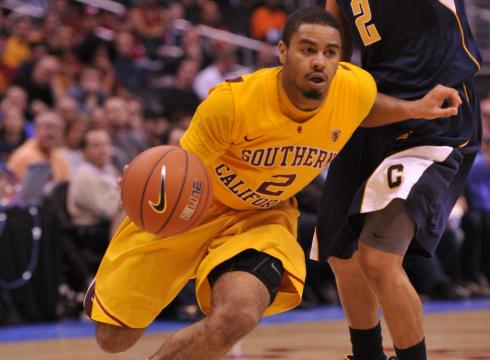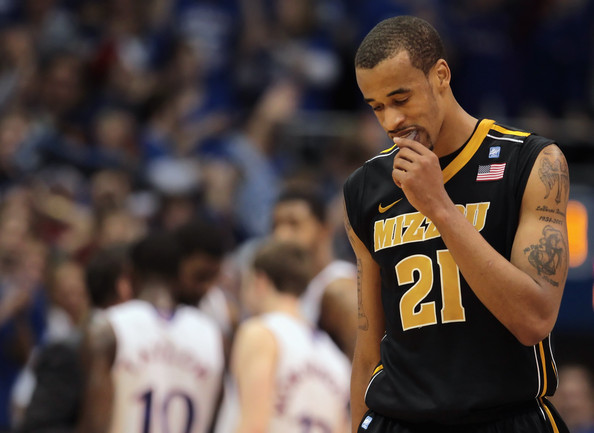ACL Well: Analyzing Six Huge Returnees From ACL Injuries
Posted by Chris Johnson on August 29th, 2012Chris Johnson is an RTC columnist. He can be reached @ChrisDJohnsonn.
The fickle nature of college hoops owes itself to a number of different factors. Every year there are a handful of teams that underperform or overperform versus expectations for various reasons, from team chemistry to coaching philosophy to collective work ethic. Perhaps the most uncontrollable element of a team’s performance is injury, the sudden and often catastrophic medical ailments that – in the blink of one single cut to the hoop, defensive rotation or hard sprint down the court – dramatically alter teams’ seasons and programs’ trajectories. Last season we saw several injuries to key players, some more impactful than others, fundamentally shift the competitive balance in various leagues. For those players, the situational outlook was bleak: not playing competitively with the team you’ve spent all summer practicing with just plain stinks. But for the most part, their departures faded into the periphery as the season wore on, players began furiously rehabbing their various injuries, teams adapted and college hoops rolled along with minimal fuss.

If Mbakwe can return to form, the Gophers could be poised for an NCAA Tournament berth (Photo credit: Tom Olmscheid/AP Photo)
There was a strikingly large proportion of one particular injury last season, or at least it seemed that way for several of the sport’s most influential medical breakdowns. It’s known as the anterior cruciate ligament (ACL) tear, and it’s one of the most common and oft-repeated of all athletic detriments. A complete recovery normally requires major surgery, between six and nine months worth of substantial rehabilitation and a cautious return to athletic activity. I’ve identified six instrumental players who experienced this very process after tearing their ACLs last season and all of them are expected to return – rehabbed and ready to go – for a redeeming 2012-13 campaign. Each player is rejoining their teams (or in some cases, new teams) under slightly different circumstances from which he left, with situational and rotational specifics dictating the terms of their returns. I’ve tried to dig into some of the circumstantial elements playing into these players’ comeback seasons and how you should expect them to fare this season. Here are the results of my research, a full-fledged breakdown of college hoops’ big-name torn ACL-returnees. Enjoy… and try your best to avoid a similar fate.
Trevor Mbakwe (sixth-year senior, Minnesota)
This isn’t unfamiliar territory for Mbakwe. Way back when he still played for Marquette – the same year (2007-08) Mario Chalmers’ legendary three-point shot KO’d a high-powered Derrick Rose-led Memphis team in the national finals – Mbakwe missed the majority of the season with a knee injury. He recovered, packed his bags and moved on to Miami Dade Community College, where he averaged a modest 16.3 PPG/13.2 RPG double-double while earning Southern Conference Player of the Year Honors. When he eventually made his way to Minnesota, after sitting out the 2009-10 season while awaiting trial for a felony assault charge, Mbakwe unleashed the ferocious rebounding and inside scoring touch he demonstrated in the JuCo ranks on Big Ten forwards. Much to the chagrin of Tubby Smith’s middling program, Mbawke had only played one full season and six full games last year before going down with an ACL tear.
The Gophers managed to flirt with the NCAA Tournament bubble for much of last season, but the loss of Mbakwe – their do-it-all big man on both ends of the floor – damaged any legitimate hopes of contending in a well-stocked Big Ten. Word out of the Twin Cities is that Mbawke’s rehab process has been overwhelmingly encouraging, so he should be good as new upon returning this fall. Provided Mbakwe can operate with the same effectiveness he flashed early on last season, the 6’8″ forward will enter a deep and talented rotation alongside promising guards Julian Welch and the Hollins brothers as well as perimeter slasher Rodney Williams and big man Elliot Eliason. If Andre Hollins uses his stellar Big Ten Tournament performance as a building block for this season, and Mbakwe regains his old form and, you know, stays on the court, a Tournament berth is a conservative expectation for the Gophers. An upper-half Big Ten finish seems likely.
Jio Fontan (fifth-year senior, USC)
Losing Fontan was just one aspect of a crippling wave of injuries last season that destroyed any chances USC had of competing in a historically putrid Pac-12. But it may have been the single most damaging loss. Fontan showed great promise in his team’s preseason foreign exhibition tour to Brazil, where he scored 57 points in two games before tearing his ACL. He was the key to Kevin O’Neill’s offensive system, and the Trojans never successfully replaced his dynamic playmaking ability. With Fontan now back in the fold, USC has the pieces in place contend for an NCAA Tournament berth just one season after hitting rock bottom with a 6-26 record. It’s not just Fontan’s return that makes such a turnaround a decent possibility. Seven-footer Dewayne Dedmon returns after sustaining various injuries last season to give USC an NBA-bound talent on the low-block. The Trojans will also receiver help from the transfer market: J.T. Terrell and Ari Stewart are making the cross-country transfer trek after successful stints at Wake Forest and should immediately become major pieces in O’Neill’s deep rotation.
With Fontan running the show, working off Terrell, Stewart and rising guard Byron Wesley and feeding Dedmon in the low post, the Trojans should tout a much improved offense. At the very least, Fontan’s development is an intriguing storyline, even if the speedy guard can’t morph USC into a Pac-12 contender. There’s no question the win total should surge from last year’s abysmal mark, but it remains to be seen whether USC can piece together an almost entirely new lineup and make it work in time for a Tournament push. Their postseason destination may come down to Fontan’s health, and whether he can recall the quickness and scoring prowess he had before the injury. For a player so heavily reliant on athleticism and speed, severe knee injuries can permanently alter the way Fontan approaches the game. If he can recall his old style, driving, cutting and actively roaming the perimeter, Fontan can keep the Trojans within striking distance of a Tournament invite. And that’s really all you can ask for after a six-win season.

Incorporating Fontan into the rotation will be key for USC’s chances in 2012-2013 (Photo credit: Robert Hanashiro/USA Today).
Dexter Strickland (senior, North Carolina)
When the Tar Heels watched talented guard Leslie McDonald go down with an ACL tear in a summer-league game, they took notice, rued the loss of depth but pressed on relatively unconcerned. After all, there was Kendall Marshall, arguably the best passing point-guard in the nation, and Strickland, a standout perimeter defender and capable ballhandler. The second part of that equation broke down once Strickland suffered the same unfortunate fate as McDonald. For the rest of the season the Tar Heels lacked backcourt depth, but they nonetheless dominated ACC competition with an NBA frontline and the nation’s best pure point guard. When the injury bug struck again – this time ending Marshall’s season in a Round of 32 Tournament matchup with Creighton – the impact of Strickland’s injury truly hit home. UNC inserted Stilman White as the starting point guard, the offense stalled, and the Tar Heels’ season ended on a depressing note with the feeling that so, so much more laid in the tea leaves if not for an unfortunate rash of injuries.
With Marshall now gone, Strickland’s health is paramount. UNC needs Strickland, who averaged 7.5 points and 2.1 assists per game in 19 appearances last season, to run the offense, play his customary brand of hounding perimeter defense, and provide veteran leadership in a rare transitioning season. In Chapel Hill, there is no rebuilding; nothing short of ACC contention is even remotely acceptable. If that’s to be the case this season, Strickland can’t afford any lingering effects from the injury to impact his role. With incoming freshman Marcus Paige waiting in the wings, any severe downturn in performance could see Strickland relegated to a reserve, particularly if Roy Williams, as expected, employs a guard-heavy lineup around emerging power forward James Michael McAdoo. UNC will rely on Strickland for his lockdown defense as much as his scoring and ball-handling. Any limitations in lateral mobility or his ability to cut could render him ineffective on the defensive end, where he’ll be charged with defending the ACC’s best scoring guards – guys like Florida State’s Michael Snaer and NC State’s Lorenzo Brown. A seamless recovery gives UNC a fair chance at challenging the top units in the ACC.
Laurence Bowers (fifth-year senior, Missouri)
Make no mistake: 2011-12 was a fantastic season for the Missouri Tigers. Rattling off 14 straight wins in non-conference play, running roughshod over league foes in the Big 12 Tournament and doing so with a guard-heavy rotation that seemed flawed from the start, all under the ominous cloud of the questionable hire of former Miami coach Frank Haith – you’d be hard pressed to find someone in Columbia who, NCAA Tournament upset notwithstanding, didn’t appreciate what their team achieved last season. It’s scary to think what Mizzou could have accomplished had Laurence Bowers, arguably the Tigers’ best player going into last season, taken part in his team’s remarkable run. Bowers’ September ACL tear prevented his participation in Haith’s inaugural season, but the injury proved a blessing in disguise. After losing Marcus Denmon, Kim English, Ricardo Ratliffe and Matt Pressey to graduation, four key contributors to last season’s successful formula, Mizzou enters 2012-13 with a revamped roster featuring an eclectic mix of unproven holdovers, a batch of talented transfers, and Bowers. The newcomers – national championship-winning big man Alex Oriakhi, perimeter scoring dynamo Keion Bell, athletic combo guard Earnest Ross and promising guard Jabari Brown – had the luxury of learning Haith’s breakneck system through practices last season (with the exception of Oriakhi, of course).
But with this many talented transfers, the sheer variance in origin of styles carries the very real risk of an incongruous and dysfunctional team dynamic. Enlisting so many talented players from so many different places isn’t necessarily a surefire recipe for success. Phil Pressey and Bowers, the team’s undisputed leaders, can mold the varying parts into a coherent and operational unit. Mizzou probably won’t deviate from the eye-defying pace they sustained last season, a style of play that requires peerless perimeter flow and efficient ball handlers. If Oriakhi mans the interior, stepping into the same role Ratliffe occupied last season, Bowers may need to stretch his game out to the perimeter in select situations to facilitate Haith’s free-flowing philosophy. Whatever the specifics guiding his positional responsibilities, Bowers needs to be at full strength in order to finish off his Tigers career on a positive note, as the sneakily athletic and deftly skilled big man of years’ past.
Branden Dawson (sophomore, Michigan State)
You might have expected the Spartans’ frontcourt to struggle in the wake of versatile forward Draymond Green’s departure. Green was the lifeblood of Michigan State’s Big Ten Championship run, the central cog guiding a talented rotation to another inspiring season. There were few teams more heavily reliant on one single player than the Spartans last season, and Day-Day’s departure will require a particularly difficult adjustment. Tom Izzo’s squad may well take a step back without him, but there’s reason to believe they can contend for another league title and enter the NCAA Tournament in favorable position for another deep run. Without Green, the offensive and defensive responsibilities will be spread out among several rising talents, none more promising than Dawson, who returns this year after tearing his ACL in a March contest against rival Ohio State. He posted respectable averages of 8.4 points and 4.5 rebounds per game before sustaining the injury, though his freshman campaign included a few moments of brilliance. In a 42-41 eyesore of a loss at Illinois, Dawson was one of the bright spots in an otherwise unsightly performance on behalf of both teams, accounting for nearly 30 percent (16) of his team’s point total along with 12 rebounds in 28 minutes.
At 6’6″, 220 pounds, Dawson brings superb interior scoring punch and attacks the glass with true Izzoian resolve. Last season, it was all about getting Dawson’s feet wet, about adjusting to the biggest, most physical league in the sport. For a true freshman – one who ranked among the Class of 2011’s top overall players – Dawson gave the Spartans more than they anticipated: an adept two-way player with a well-grounded understanding of Izzo’s philosophy and expectations, a tireless worker on both ends of the floor, and a tactically-proficient scorer with an indomitable drive to outwork the opposition. The question is whether Dawson can use last season as a foundation from which to build the final three years of his college career. He started several games last season, but was rarely charged with carrying the scoring load (such is one of many perks you experience playing alongside Green). This year Dawson will figure heavily into the Spartans’ offensive plans. Working alongside robust (and vegetarian) center Derrick Nix and developing big man Adreian Payne, Dawson could stand as the Spartans’ go-to low post option. Even at this early stage, Dawson has proven a more adept scorer than his older frontcourt mates. The size and variety of developmental leap he takes this season will depend in large part on the status of his rehabbing knee. Dawson’s recovery is proceeding as planned. So barring any setbacks, Michigan State fans should expect a speedy return to the court. Dawson is a star in the making, and he’ll begin to prove as much – knee permitting – in the fall.
JT Thompson (sixth-year senior, Charlotte)
The story of JT Thompson draws parallels to the injury-plagued career of former Purdue forward Robbie Hummel. Twice Thompson tore his ACL, like Hummel, and now he’s back for a sixth and final year of eligibility. Before consecutive knee surgeries sidelined him for two full seasons, Thompson was a nice sparkplug off the bench for former Hokies’ coach Seth Greenberg. His shooting percentage declined over three years at Virginia Tech, but his rebounding total spiked in his final season with the program. Thompson was an active interior presence and – with decent scoring touch, superb athleticism and relentless ballstopping intensity, all packaged within a 6’6″, 265-pound frame – one of the ACC’s premier defenders. Thompson’s success in that area owes itself in large part to his speed, lateral quickness and active man-to-man style, which casts significant doubts on a successful return to the sport. To resurface as the player he once was, Thompson needs his athleticism. He needs to regain the ability to block shots and lock down opposing forwards. Thompson is not the sort of crafty, highly-skilled tactician who can thrive on talent alone; he must have his full repertoire of athletic tools at his disposal.
The twice-repaired Thompson transferred away from the Hokies last season and landed in Charlotte, where the 49ers will play their final season in the Atlantic 10 before moving on to Conference USA. Alan Major’s team is headed in the right direction, and with leading scorer Chris Braswell and promising guard Demario Mayfield in tow, the 49ers are well on their way toward legitimate improvement. Throw Thompson in the mix, and the 49ers may have the right blend of veteran savvy and young talent to surprise some negligent onlookers in the Atlantic 10. As much as Thompson’s transfer may or may not help the 49ers, finishing in the top half of the league standings feels like the best-case scenario. From Butler to Dayton, Saint Louis to Saint Joseph’s, UMass to Temple, VCU to Xavier, the A-10 is teeming with at-large contenders. Even if Thompson regains his athletic brand of play, and Braswell shines alongside him, the 49ers don’t have the firepower to run with the league elite. Thompson’s final season could still be a strong one, but it probably won’t include a favorable postseason destination.













































